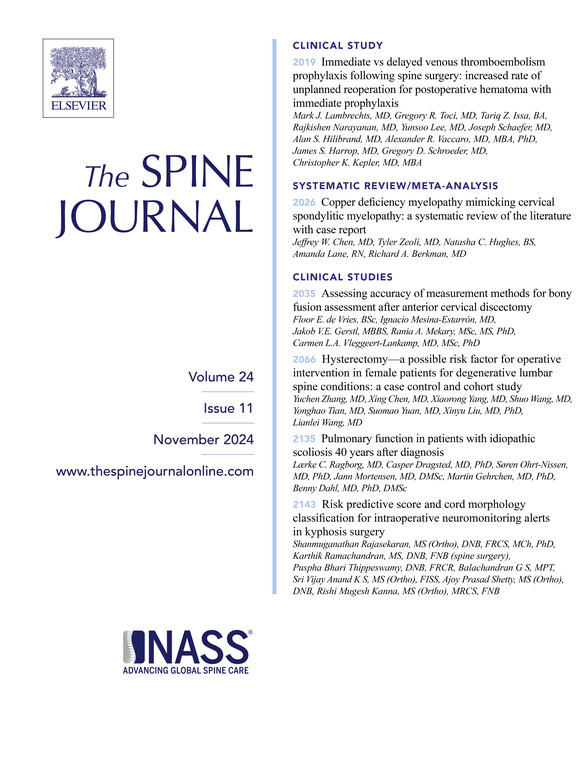A cost-effectiveness analysis of intraosseous basivertebral nerve ablation for the treatment of chronic low back pain
IF 4.9
1区 医学
Q1 CLINICAL NEUROLOGY
引用次数: 0
Abstract
BACKGROUND CONTEXT
Randomized trials have demonstrated the superiority of intraosseous basivertebral nerve ablation (BVNA) compared with sham and standard care in terms of improvements in pain, disability, and health-related quality of life in patients with vertebrogenic chronic low back pain (cLBP).
PURPOSE
To assess the cost effectiveness of BVNA in patients with vertebrogenic cLBP compared to standard care alone.
STUDY DESIGN/SETTING
A model-based economic analysis.
PATIENT SAMPLE
Base case analysis used INTRACEPT, a randomized trial comparing BVNA with standard care in 140 patients with vertebrogenic cLBP, recruited from 23 sites across the United States, with a follow-up, up to 5 years. Scenario analyses compared data from the Surgical Multicenter Assessment of Radiofrequency Ablation for the Treatment of Vertebrogenic Back Pain (SMART) randomized trial against a sham control, and a single-arm study.
OUTCOME MEASURES
Costs and quality-adjusted life years (QALYs) were calculated to determine the incremental cost-effectiveness ratio (ICER).
METHODS
A cost-effectiveness model was built in Microsoft Excel to evaluate the costs and health outcomes of patients undergoing BVNA using the Intracept Procedure (Relievant Medsystems) to treat vertebrogenic cLBP from a US payor perspective. Alternative scenario sensitivity analyses and probabilistic sensitivity analyses were conducted to assess the robustness of the model results. QALYs were discounted at 3.0% per year.
RESULTS
Base case analysis showed that BVNA relative to standard care alone was a cost-effective strategy for the management of patients with vertebrogenic cLBP, with an ICER of US$11,376 per QALY at a 5-year time horizon from introduction of the procedure. Modeling demonstrated a >99% probability that this was cost effective in the US, based on a willingness-to-pay threshold of US$100,000 to US$150,000. Various sensitivity and scenario analyses produced ICERs that all remained below this threshold.
CONCLUSIONS
BVNA with the Intracept Procedure offers patients with vertebrogenic cLBP, clinicians, and healthcare systems a cost-effective treatment compared to standard care alone.
骨内椎基底神经消融术治疗慢性腰背痛的成本效益分析。
背景情况:随机试验证明,与假性治疗和标准治疗相比,椎体内椎体基底神经消融术(BVNA)在改善椎源性慢性腰背痛(cLBP)患者的疼痛、残疾和健康相关生活质量方面更具优势。目的:评估椎源性慢性腰背痛患者接受BVNA治疗与单独接受标准治疗的成本效益:研究设计/设置:基于模型的经济分析:基础病例分析使用了 INTRACEPT,这是一项随机试验,对 140 名椎体源性 cLBP 患者的 BVNA 与标准护理进行了比较,这些患者是从美国 23 个地点招募的,随访时间长达 5 年。情景分析比较了射频消融治疗椎体源性背痛(SMART)随机试验与假对照以及单臂研究的数据:计算成本和质量调整生命年 (QALY),以确定增量成本效益比 (ICER):用 Microsoft Excel® 建立了一个成本效益模型,从美国支付方的角度评估使用 Intracepture 程序(Relievant Medsystems)进行 BVNA 治疗椎源性 cLBP 患者的成本和健康结果。为评估模型结果的稳健性,还进行了替代方案敏感性分析和概率敏感性分析。QALYs的贴现率为每年3.0%:基础病例分析表明,相对于单纯的标准护理,BVNA 是治疗椎源性 cLBP 患者的一种经济有效的策略,在引入该手术的 5 年时间跨度内,每 QALY 的 ICER 为 11,376 美元。根据 100,000 美元至 150,000 美元的支付意愿阈值,建模结果表明,在美国,这种方法具有成本效益的可能性大于 99%。各种敏感性分析和情景分析得出的ICER均低于这一临界值:结论:与单纯标准治疗相比,采用 Intracept 程序的 BVNA 为椎体源性 cLBP 患者、临床医生和医疗系统提供了一种经济有效的治疗方法。
本文章由计算机程序翻译,如有差异,请以英文原文为准。
求助全文
约1分钟内获得全文
求助全文
来源期刊

Spine Journal
医学-临床神经学
CiteScore
8.20
自引率
6.70%
发文量
680
审稿时长
13.1 weeks
期刊介绍:
The Spine Journal, the official journal of the North American Spine Society, is an international and multidisciplinary journal that publishes original, peer-reviewed articles on research and treatment related to the spine and spine care, including basic science and clinical investigations. It is a condition of publication that manuscripts submitted to The Spine Journal have not been published, and will not be simultaneously submitted or published elsewhere. The Spine Journal also publishes major reviews of specific topics by acknowledged authorities, technical notes, teaching editorials, and other special features, Letters to the Editor-in-Chief are encouraged.
 求助内容:
求助内容: 应助结果提醒方式:
应助结果提醒方式:


